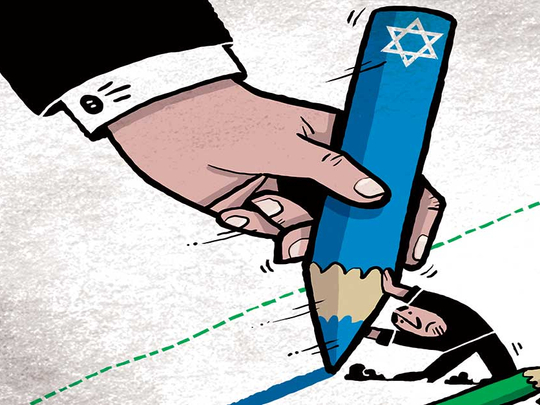
The Palestinian community of occupied Jerusalem proved cap-able of defeating Israeli plans to change the status of Al Aqsa Mosque. This is a small victory, but a pivotal one that should be savoured and emulated as a form of popular resistance throughout Palestine.
The birth of this movement has arrived at a critical time as Israel is currently working to seal the fate of East Jerusalem, occupied during the war of 1967 and illegally annexed by the Israeli government in 1981. Two detrimental legislative initiatives are presently being pursued by the Israeli Knesset (parliament). One would require a two-thirds majority in the Knesset to concede any parts of occupied Jerusalem, and would redraw the borders of the city to exclude Palestinian neighbourhoods, thus rendering the Palestinian population — already a minority — an even smaller minority.
The second initiative would once again push the borders of the so-called Greater Jerusalem further, to include the massive illegal colonies of Ma’ale Adumim, Gush Etzion bloc, Givat Ze’ev, Efrat and Beitar Illit. This would serve to augment the percentage of Jewish majority in the city.
In fact, Beitar Illit is currently being expanded to cut off occupied Jerusalem from the occupied West Bank.
However, the resolve and courage shown by thousands of Palestinians in occupied Jerusalem in recent weeks is a reminder that the Palestinian people have not given up, and are capable of challenging the Israeli designs even if left fighting alone. Indeed, neither Fatah nor Hamas has been of much relevance to the mass protests staged around Al Aqsa Mosque since mid-July. Neither have American pressure, half-hearted European ‘concern about the situation’ or cliched Arab declarations made an iota of difference. Israel shut down Al Aqsa compound on July 14, following a shootout between three armed Palestinians and Israeli occupation officers. When the compound was re-opened a few days later, Palestinian worshippers refused to enter, as massive security installations — gates, cameras and metal detectors — were installed.
The people of occupied Jerusalem understood the motive behind Israel’s action — these security measures were a facade aimed at exploiting the situation to change the status of Al Aqsa, as part of its efforts to further isolate Palestinians and Judaise the illegally occupied city.
For 50 years, occupied Jerusalem has endured daily battles. The Israelis fought to expand their influence in the city, increase the number of illegal Jewish colonists and cut off occupied Jerusalem from the rest of the Palestinian Territories, while Palestinians, Muslim and Christians alike, fought back.
Al Aqsa compound — also known as Al Haram Al Sharif or the Noble Sanctuary — is the most symbolic element in the fight. It is a microcosm of the fate of the occupied city — in fact, the fate of the entire Palestinian land.
Palestinians understand that the fate of their mosque and the future of their city are tightly linked. For them, if Al Aqsa is lost, then occupied Jerusalem is truly conquered.
Palestinian youth, many born after the failed Oslo Accords, are fed up as the Israeli military controls every aspect of their lives and their corrupt leadership grows more irrelevant and self-serving.
Popular solidarity
The shootout of July 14 could have been noted as yet another violent episode of many that have been reported in occupied Jerusalem in recent months. Following such events, Israel’s response ignores the military occupation entirely, focusing instead on its security problem caused by ‘Palestinian terror’. Politicians then react by implementing new laws, proposals and radical ideas to exploit a tragic situation and remould the status quo.
In this latest confrontation, Palestinians of occupied Jerusalem won, presenting an impressive model of mobilisation and popular solidarity for all Palestinians. The Israeli army removed the barricades and the metal detectors, pushing Israel to the brink of a political crisis involving angry politicians, the army and internal intelligence, the Shin Bet. The people’s victory was a massive embarrassment for Mahmoud Abbas, the President of the Palestinian National Authority in Ramallah who tried to ‘piggyback off the protests’ but failed. Other factions, too, moved quickly, trying to mobilise on the back of the people’s victory, but their efforts have appeared staged and insincere.
This grassroots movement comprised thousands of women, men and children. They included Zeina Amro, who cooked daily for those who held steadfast outside the compound. Despite being shot by a rubber bullet, she returned to urge the men to stand their ground the following day. It also includes the child, Yousuf Sakafi, whose chores included splashing water over people as they sat for endless hours under the unforgiving sun, refusing to move. Palestinian Christians showed their support too as they arrived to pray with their Muslim brethren.
Palestinians must now continue their mobilisation inspired by the movement that successfully defended Al Aqsa. It is these ordinary individuals, like of Zeina, Yousuf and thousands more that kept the Palestinian struggle for occupied Jerusalem, for Palestine, alive all these years.
Dr Ramzy Baroud is an internationally-syndicated columnist, a media consultant, an author of several books and the founder of PalestineChronicle.com. His latest book is My Father Was a Freedom Fighter: Gaza’s Untold Story.










